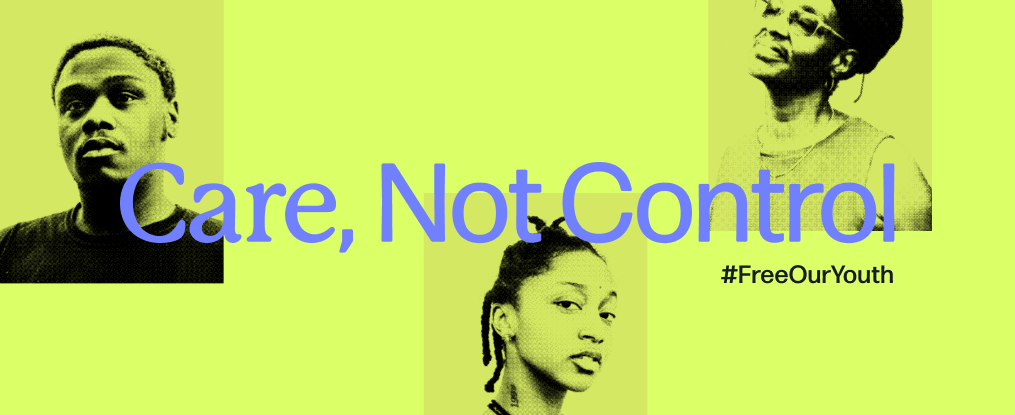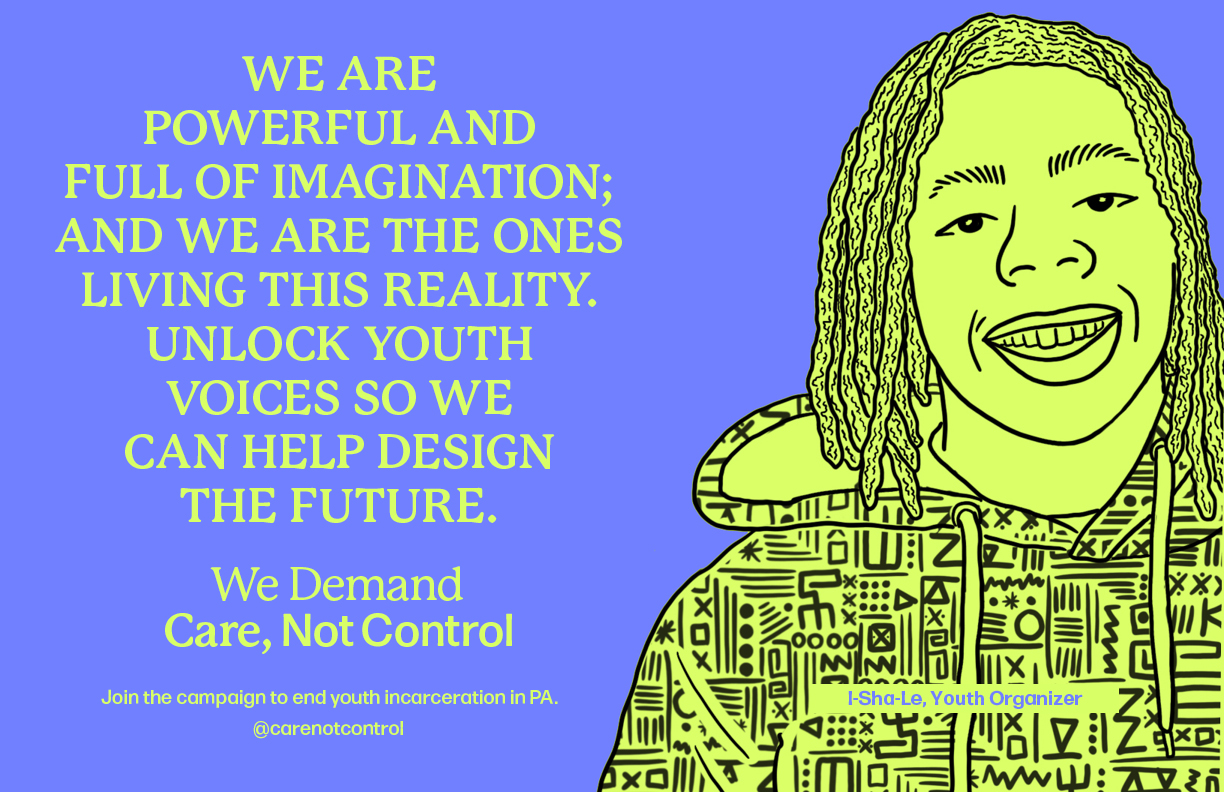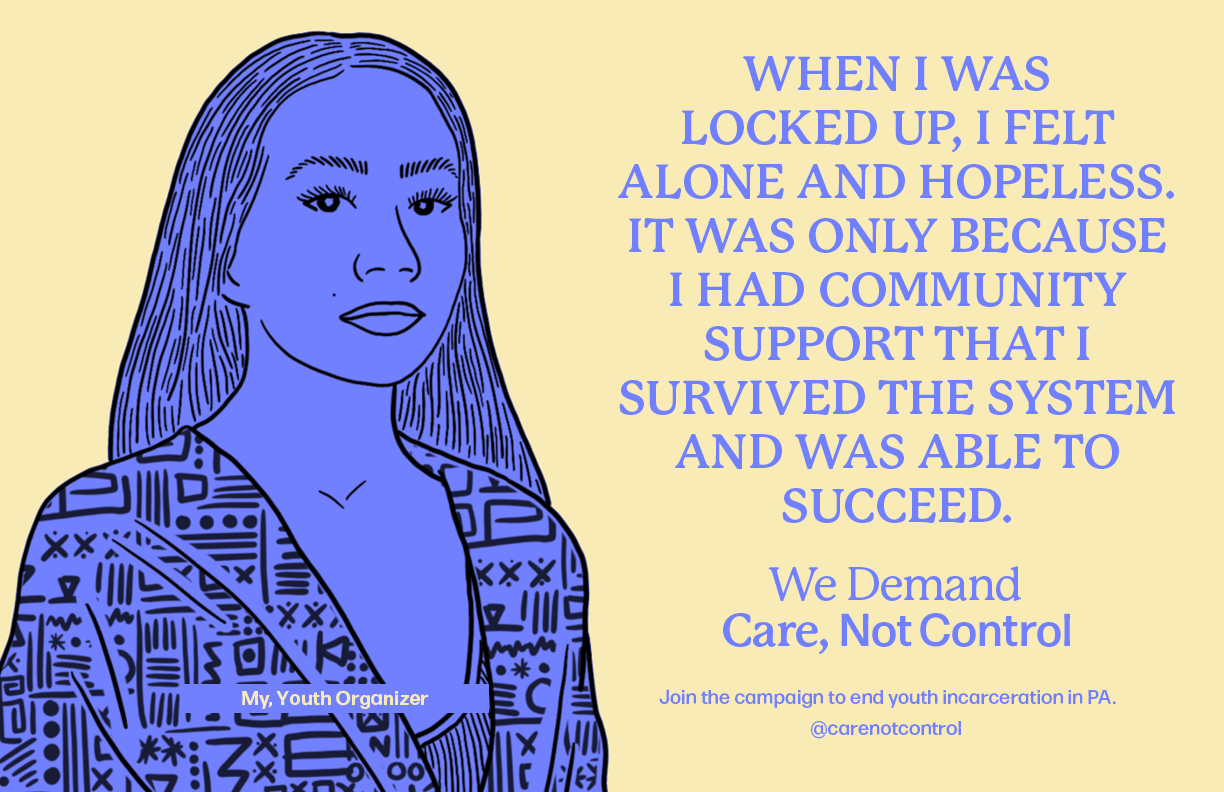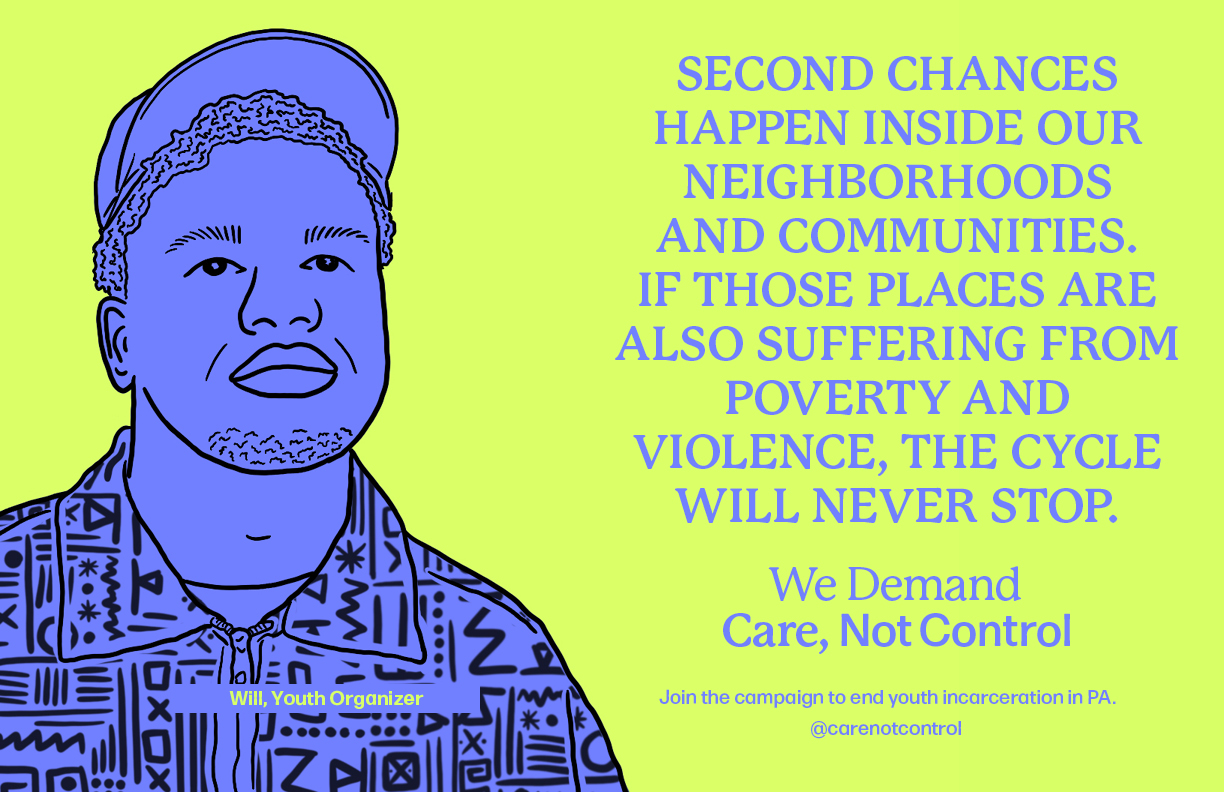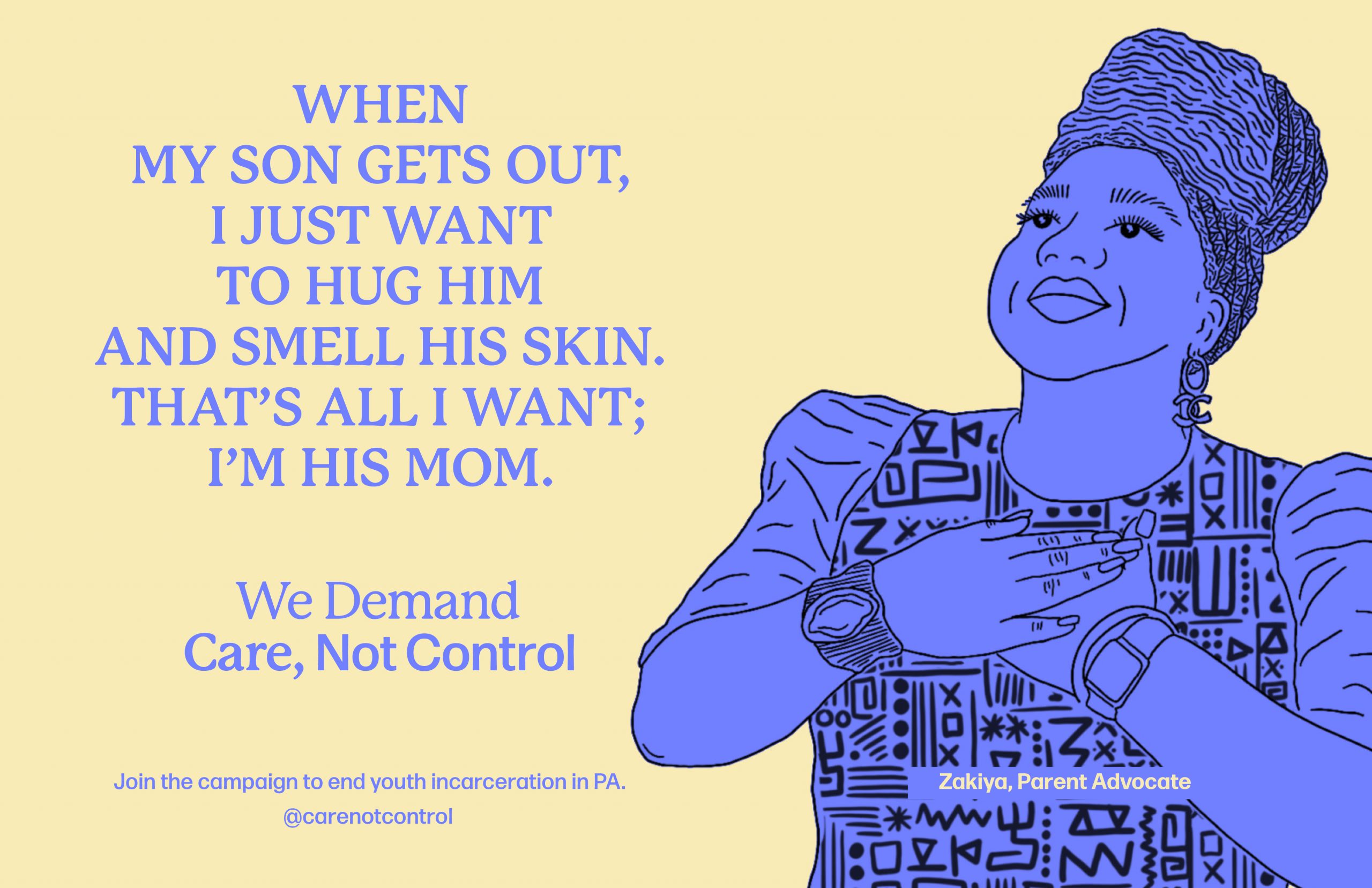We demand care, not control.
For Immediate Release: November 12, 2021
Contact: Ivonne Rodriguez, ivonne.rodriguez@berlinrosen.com; Michaela Pommells, michaela@villagearts.org
Glen Mills School Can’t Erase Decades of Abuse with a New Name
Following yesterday’s announcement that the Glen Mills Schools — which was shutdown in 2019 after decades of systemic child-abuse and cover-ups — is seeking to reopen under a new name. The Care, Not Control Coalition released the following statement:
“Any organization that worked overtime to cover up decades of abuse of young people under their care does not deserve to operate a business again. Glen Mills has shown they are unfit to care for children — and a new name doesn’t erase the harm they caused to Pennsylvania’s youth. They do not deserve a second chance — dehumanizing students was part of the Glen Mills curriculum.
Granting this stained, violent institution an opportunity to reopen sends a message to the hundreds of children and their families that their endured abuse, their broken bones, trauma, and unanswered cries for help don’t matter. The Glen Mills abuses helped create a bipartisan Task Force to protect vulnerable youth in 2019, but no legislation has been introduced from that effort. Instead, more instances of horrific abuse of children in state sanctioned facilities have come to light. Allowing Glen Mills to reopen would show that we’ve learned nothing from these scandals. Our state should not be willing to sit by and risk allowing more children to be harmed again.The horrors at Glen Mills must never be repeated.
We call on Governor Wolf and the Pennsylvania Department of Human Services to put Pennsylvania’s children first and reject this request. It’s time to invest the millions of Pennsylvanian tax dollars funneled annually into Glen Mills into robust community programming to help our youth heal at home.”
WHO ENDORSES #CARENOTCONTROL?
62 ORGANIZATIONS, GROUPS, AND EXPERTS ENDORSE CARE, NOT CONTROL DEMANDS
Read a full list of our supporters at the link above.
We are a coalition of young people and youth advocates working to end youth incarceration. Together, we’ve created a vision for, and action steps towards, ending youth incarceration in Pennsylvania once and for all.
The story of youth incarceration in Pennsylvania is one of ineffective spending, racial discrimination11. In 2018, Black youth accounted for 38% of written allegations, but 62% of detention decisions and 47% of placement decisions. White youth accounted for 45% of written allegations, but only 20% of detention decisions, and only 34% of placement decisions. http://www.pacourts.us/assets/files/page-1316/file-9928.pdf?cb=1602129738094, and unchecked abuse; of children being locked in adult jails; of life-altering trauma.
As you read our platform, we want you to remember this: we are not just working to end inhumane, ineffective, and racist practices—we are working to build a new world where every young person has a chance to thrive.
This new world is invested in care, rather than control.
In this new world:
I see families reminiscing over a photo album full of pictures of every family member, full of memories of being together because they were never forced to be apart.
Instead of asking, how will I survive today? I see myself asking, what business do I want to run? What school do I want to go to? What neighborhood do I want to live in?
I see a childhood that is actually playful—full of joy. Where I don’t have to be extra tough like I have no feelings. I can just be me.
Instead of nightmares, kids can actually dream in peace.
— Responses from youth with experience in the criminal justice system, 2020
This world is within our reach.
We have everything we need to create it, starting today.
Download posters here to print or share via social media in support of #CareNotControl
We have the data. The data tells us that punitive models of control don’t work. Annually, 3,000 children and teens are locked in carceral22. By the term “carceral settings,” we refer to detention centers, as well as both private and state-run placements, including secure and more open-campus settings, as well as adult jails and prisons that house youth. According to the data compiled by the Pew Charitable Trusts for the PA Juvenile Justice Task Force, in 2018, approximately 3,000 youth were held in carceral settings in 2018, the year for which the most recent data is available. settings where they experience violence instead of justice; neglect instead of guardianship; and stagnation instead of growth. Black and Latinx youth are more likely than White youth to receive punitive sentences such as incarceration or transfer to adult court,33. In 2018, Black youth identified as male accounted for 7% of Pennsylvania’s population, but 56% of adult prosecution filings and 57% of adult convictions. Latinx youth identified as male accounted for 6% of Pennsylvania’s population, but 15% of adult prosecution filings, and 16% of adult convictions. White youth identified as male accounted for 36% of Pennsylvania’s population, but only 21% of adult prosecution filings. while White youth are more likely to receive probation44. BIPOC are disproportionately unlikely to receive probation compared to White youth. In 2018, Black youth represented 41% of adjudications, but only 34% of those who received probation as a first option. White youth represented 40% of adjudications, but represented 47% of those who received probation as a first option. Latinx youth identified as female averaged the longest time on probation with 15 months. Black youth also spent more time under court supervision as a whole than White youth where probation was the initial court response. and diversion programs55. Similar racial disproportionality exists with respect to what youth are deemed eligible for diversion programs and consent decrees: In 2018, Black youth identified as male accounted for 28% of written allegations, but only 22% of pre-petition diversion. that allow them to remain in their communities, despite similar levels of engagement in delinquent behavior.
We have the resources. The amount spent on youth prisons could be transformative if channeled into care-based resources. Each year, we spend an average of $211,000 to incarcerate a child compared to the $16,000 on average that we spend to educate a child.
And we have both the wisdom and ingenuity needed to establish and maintain alternatives to incarceration that support safety and wellbeing for all of Pennsylvania’s children.
The Care, Not Control campaign seeks to end youth incarceration in Pennsylvania. We urge decision-makers to take the following
critical first steps* in achieving this goal.
1. End the carceral state for youth in Pennsylvania
“I did come out of prison a different person — but I DID NOT come out a better person. I came out more angry, more physically and mentally unhealthy, and more lost than I had ever been.” – young adult formerly incarcerated as a child in adult prison
- Do not build or invest in building new juvenile correctional facilities (including placements or for detention), or separate facilities designed to house youth charged as adults.
- Do not reopen Glen Mills or Wordsworth Academy or any other facility that has been deemed unsafe to house young people.
- Never hold youth in prison-like settings.
- Establish and utilize alternatives to restrictive and prison-like settings for youth who have been deemed to need to be held.
- Until alternatives have been established, utilize the least restrictive and least prison-like settings when holding youth who have been deemed to need to be held.
- Establish, utilize, and sustain alternatives to incarceration in order to safely release and support all youth who are incarcerated in PA.
- Never detain for any period of time young people who meet the following criteria:
- are under the age of 14;
- are charged with a status offense, probation violation, misdemeanor, nonviolent offense, or non-payment of fines, fees or restitution;
- are pregnant or who are parents to children who were born in the past year.
- Only allow for a young person to be temporarily separated from their community if it is determined that (1) the young person’s behavior poses an immediate, specific and substantial risk of physical harm to another person and, (2) no condition or combination of conditions can provide for that young person to be safely returned to the community at the present moment. This determination cannot be made based solely on the type of case a young person is charged with.
2. Divest from youth incarceration and reinvest in communities
“In the future we could work together to build the communities we deserve and create better options. We could fund schools, businesses, gardens, art.” — young adult formerly incarcerated in a juvenile carceral setting
-
- Invest in and expand the availability of restorative practices to all children with the intent to halt new admissions to the juvenile justice system and end the damage perpetrated by holding youth in carceral settings.
- Require financial savings from removing youth from detention and placement to be invested in evidence-based, community-based and anti-racist alternatives that focus on healing, restorative justice and violence prevention, and are not run/supervised by probation/law enforcement.
- Establish a statewide youth and family advisory group and support county-level advisory groups to ensure that these alternatives and budget allocations are vetted and supported by meaningful youth and family participation.66. Under Title V of the JJDPA, federal funding is available to support this strategy as part of the Youth PROMISE Act.
- Create financial incentives for counties to create a state fund to help start evidence- and community-based, non-residential programs, and reallocate law enforcement funding to programming, essential needs and services in communities, especially in communities where there are high rates of poverty.
3. Always treat children as children.
“Prison takes important parts of you that you can never get back—especially when you are young. It forces you to live with horrible things for the rest of your life—some things you’ve seen happen, and some things that have been done to you.” — young adult formerly incarcerated as a child in adult prison
-
- Amend state law to eliminate the practice of prosecuting youth under age 18 as adults, both through direct file prosecution and the certification/transfer process.77
- In the interim, direct counties to come into compliance with the Juvenile Justice & Delinquency Prevention Act (JJDPA) and the Prison Rape Elimination Act (PREA) by prohibiting the detention of children under 18 in adult jails or prisons for any reason.
4. Provide holistic support to young people as they await release
“I survived because my mom always came to see me—But most people around me didn’t care about their life anymore. They didn’t have a home, outside of prison or in prison. Prison broke them apart from any community they had.” – young adult formerly incarcerated as a child in adult prison
- Develop, enforce, and publicly release a set of mandates for ensuring the health and wellbeing of youth held in any form of confinement that:
- Prohibit the use of solitary confinement, seclusion, exclusion or any type of isolation as a containment measure;
- Provide age-appropriate and accessible written and verbal communications to youth about COVID-19 or other highly infectious diseases, access to medical care, and community based supports;88. Framed in October of 2020, the Coalition makes this suggestion and the above while taking into consideration CDC health and safety recommendations.
- Ensure access to meaningful, high-quality, anti-racist education with in-person teachers and age-appropriate, individualized opportunities to learn and grow;
- Ensure access to legal counsel through video and teleconferencing if in-person access is unavailable or unsafe due to COVID-19 safety precautions;
- Ensure access to family contacts and support networks by guaranteeing free unlimited phone calls and increased video conferencing opportunities for all youth in custody if in-person access is unavailable or unsafe due to COVID-19 safety precautions;
- Ensure all youth and their families and support systems have access to interpreters/translators; and
- Require any setting that holds youth to have community-based accountability mechanisms that ensure the design and implementation of programs are healing-centered, trauma-informed, youth-centered and rooted in restorative justice and anti-racist principles.
5. Transform probation and eliminate fines and fees
“Second chances happen inside our neighborhoods and communities. If those places are also suffering from poverty and violence, the cycle will never stop.” — young adult formerly incarcerated as a child in adult prison
-
- Eliminate incarceration as an option for violations of probation.
- Eliminate all court fines and fees.
- If it is determined through a restorative process that a young person should repair a financial harm through restitution, ensure that any payment plan is directly related to a young person’s access to financial resources and ability to pay.
- During the COVID-19 pandemic, place a moratorium on all probation-ordered programs, community service and labor.
6. Provide holistic support to young people returning home
“When I was locked up, I felt isolated, alone and hopeless. It was only because I connected with community organizations that I survived the system and was able to come home and succeed.”
— young adult, formerly incarcerated in a juvenile carceral setting
-
- When youth are released from custody, create a comprehensive individualized transition plan to ensure that:
- They have a place to live;
- They have immediate access to Medicaid, adequate medical and behavioral healthcare, and at least a 30-day supply of any prescribed medications;
- They are enrolled in or connected to age-appropriate, anti-racist and culturally appropriate education opportunities;
- They are connected to appropriate community-based programming;
- They have access to therapeutic support;
- They have access to technological devices (phones, computers, laptops) to ensure they can communicate consistently with family members or support network members; and
- Youth are not handcuffed or shackled during transport.
- When youth are released from custody, create a comprehensive individualized transition plan to ensure that:
7. Release youth in light of the heightened dangerousness of the COVID-19 Pandemic
“My child has asthma. If he dies from COVID at CFCF, is the mayor going to give me a tweet to say he’s sorry? I won’t even have the chance to say goodbye.” — mother of a currently incarcerated child
- Because of COVID-19, require each juvenile court, and adult criminal court with jurisdiction over youth who were charged and/or sentenced as adults, to review all youth currently held in detention or placement and release them unless there is a judicial determination made that the young person should be temporarily separated from their community if it is determined that (1) the young person’s behavior poses an immediate, specific and substantial risk of physical harm to another person and, (2) no condition or combination of conditions can provide for that young person to be safely returned to the community at the present moment. This determination cannot be made based solely on the type of case a young person is charged with.
Join us! To support the #CareNotControl campaign, please:
Use posts from our social media toolkit to share these demands.
Endnotes
* These demands represent initial and/or interim steps that are critical to achieving our ultimate goal of ending youth incarceration in Pennsylvania. The scope and substance of these demands will continue to evolve in response to future legislative decisions, socio-economic conditions and events, and campaign participants’ individual and collective knowledge.
1. In 2018, Black youth accounted for 38% of written allegations, but 62% of detention decisions and 47% of placement decisions. White youth accounted for 45% of written allegations, but only 20% of detention decisions, and only 34% of placement decisions. http://www.pacourts.us/assets/files/page-1316/file-9928.pdf?cb=1602129738094
2. By the term “carceral settings,” we refer to detention centers, as well as both private and state-run placements, including secure and more open-campus settings, as well as adult jails and prisons that house youth. According to the data compiled by the Pew Charitable Trusts for the PA Juvenile Justice Task Force, in 2018, approximately 3,000 youth were held in carceral settings in 2018, the year for which the most recent data is available.
3. In 2018, Black youth identified as male accounted for 7% of Pennsylvania’s population, but 56% of adult prosecution filings and 57% of adult convictions. Latinx youth identified as male accounted for 6% of Pennsylvania’s population, but 15% of adult prosecution filings, and 16% of adult convictions. White youth identified as male accounted for 36% of Pennsylvania’s population, but only 21% of adult prosecution filings.
4. BIPOC are disproportionately unlikely to receive probation compared to White youth. In 2018, Black youth represented 41% of adjudications, but only 34% of those who received probation as a first option. White youth represented 40% of adjudications, but represented 47% of those who received probation as a first option. Latinx youth identified as female averaged the longest time on probation with 15 months. Black youth also spent more time under court supervision as a whole than White youth where probation was the initial court response.
5. Similar racial disproportionality exists with respect to what youth are deemed eligible for diversion programs and consent decrees: In 2018, Black youth identified as male accounted for 28% of written allegations, but only 22% of pre-petition diversion.
6. Under Title V of the JJDPA, federal funding is available to support this strategy as part of the Youth PROMISE Act.
7. Recent data from Pew Charitable Trusts, prepared for the PA Juvenile Justice Task Force, found that 245 children were prosecuted as adults across Pennsylvania in 2018. 80% of those cases were filed directly in criminal court without judicial review. Black youth identified as male accounted for 57% of those cases, while only making up 7% of the statewide youth population. When looking at transfer hearings, White youth were far more likely to remain in juvenile court than youth of color, and youth of color were more likely to receive sentences of confinement if convicted in criminal court after a transfer hearing. Overall, confinement was the most common sentence for all youth convicted as adults.
8. Framed in October of 2020, the Coalition makes this suggestion and the above while taking into consideration CDC health and safety recommendations.
14. Recent data from Pew Charitable Trusts, prepared for the PA Juvenile Justice Task Force, found that 245 children were prosecuted as adults across Pennsylvania in 2018. 80% of those cases were filed directly in criminal court without judicial review. Black youth identified as male accounted for 57% of those cases, while only making up 7% of the statewide youth population. When looking at transfer hearings, White youth were far more likely to remain in juvenile court than youth of color, and youth of color were more likely to receive sentences of confinement if convicted in criminal court after a transfer hearing. Overall, confinement was the most common sentence for all youth convicted as adults.
Read, download and share a PDF of our demands here.
[pdf-embedder url=”https://villagearts.org/wp-content/uploads/2020/10/CareNotControl-Platform-_10_20.pdf” title=”#CareNotControl Platform _10_20″]
This campaign is a collaboration by:
